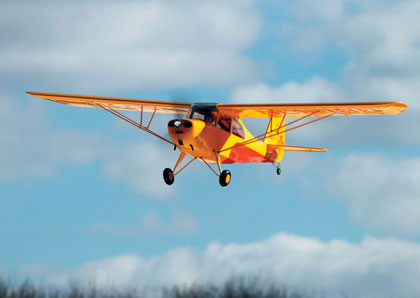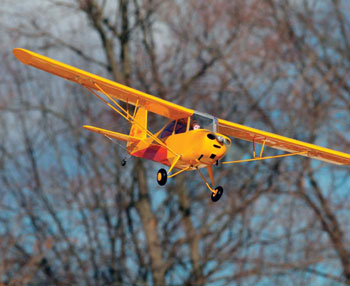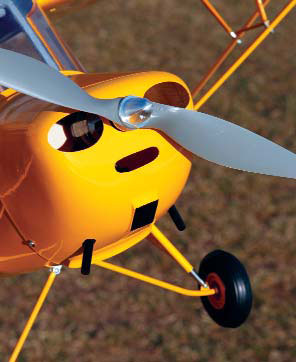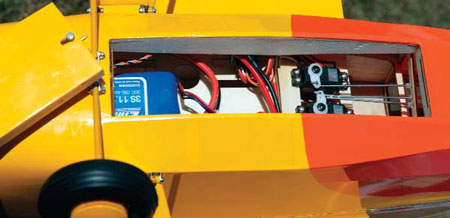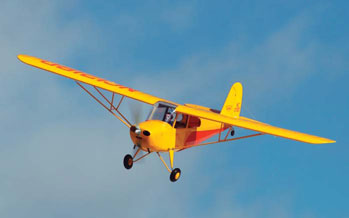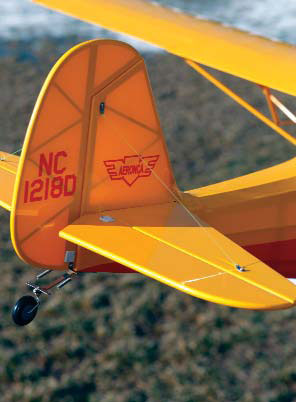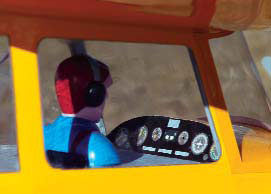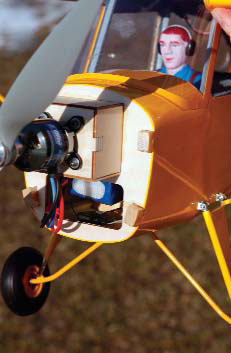|
|
|||||||||||||||

On any given weekend at my local airport I can count on there being a few different types of aircraft in the pattern during the day. One of the most recognizable is the Aeronca 7AC Champion with its yellow and orange trim. Most everyone refers to this classic as a “Champ”, so I will too from here on out. The Champ was one of general aviation’s most successful post-war aircraft. It was designed to compete with the Piper Cub which had been in the air for almost 10 years when the Champ first took to the skies in 1944. For a period of about five years, at the company’s height, Aeronca was producing 50 light aircraft per day. Well within a decade, more that 10,000 Champs had been produced. |
|||||||||||||||
|
|||||||||||||||
|
|||||||||||||||
|
line tail bracing stay faithful to the full scale’s geometry and add functional support. The spring-dampened steerable tail wheel and shock absorbing landing gear put this model into its own league and make controlling the Champs time on the ground as comfortable as when it’s in the air. The main wheels are even accented with hub caps. Further enhancing the Champ are several other thoughtful features. Having a twopiece plug in wing makes storage much more convenient. The large hatch on the belly utilizes a spring-loaded pin for toolfree access when swapping out the battery. Assembly of the horizontal stabilizer is quick and accurate with dowels on each side that plug into the tail for gluing. The control surfaces on the wing and elevator come pre-installed and the rudder is preslotted. connection points for all hardware come pre-drilled to further ensure accuracy and speed assembly. The front windshield, skylight and four cabin windows come already trimmed to a perfect fit. As a ‘Platinum Series’ model, the Champ features many details that faithfully replicate the fullscale design and provide for rapid and enjoyable assembly of this model. Finish off with the cockpit detail and the optional pilot figure and you have a superior sportscale replica of a post-war trainer classic. |
|||||||||||||||
|
|||||||||||||||
|
|||||||||||||||
|
|||||||||||||||
|
On this first windy flight, the plane looked like a cork bobbing in a rough sea as first one wing and then the other was lifted by wind gusts. As I chased the bumps with a good amount of roll input it was apparent that the model shares the full scale Champ’s proclivity for adverse yaw. This is a tendency for the nose to yaw to the outside of a turn, instead of tracking smoothly through the turn. The rising wing is generating more lift and also creating more drag which slews the nose opposite to the bank. This tendency is minimized by following the manual and programming aileron differential. This gives more travel to the aileron that is moving up and less to the aileron moving down, thus evening out the drag. Considering the relative conditions, that first flight happened on a day no responsible full scale would have opened the hangar door! |
|||||||||||||||
|
|||||||||||||||
|
On subsequent days with calm air I have been able to really explore the nature of the Champ, and come to appreciate why the full-scale design was so successful as a learning platform for new pilots and as a fun weekend adventurer. Adding enough throttle to get it rolling on grass gives a leisurely take off run that breaks free of the ground in around 15 paces and lets it just float off the ground. The model has smooth, gentle flying characteristics with a stall that results in nothing more than a straightahead dip of the nose and no tip of the wing. Release the right stick and it’s flying again. All other control inputs are rendered smoothly. |
|||||||||||||||
|
|||||||||||||||
|
One of the best lessons to be learned in flying is coordinating all aileron inputs with rudder. You can let off the rudder once established in a bank, but if you don’t add rudder any time you touch the ailerons you will see the nose drifting. The Champ has a playful side as well. With the recommended power system, it is a very capable high-wing aerobat. Kick hard on the rudder and the Champ establishes a nice spin that stops immediately when you neutralize the controls. Adding more power will tighten the spin even further. Roll performance, even on high rates, is leisurely and big barrel rolls look great. Gigantic loops as a thing of ease with so much power. Yet what I enjoy most about the Champ is floating around in calm skies on low-rates gracefully carving through the air as realistically as possible. |
|||||||||||||||
|
|||||||||||||||
|
At some point, you always have to think about returning home. The effective rudder can make for a wonderful slip on approach. Keep a little power on during the final descent and then zero out the throttle once you’ve crossed the landing threshold. Depending on how much airspeed remains to bleed off, the Champ will float for a bit before settling in on the runway. The real joy comes at touchdown. Touch and go’s and full stop landings with the sprung undercarriage are what separate this model from others. Even if you flare a little bit too high and it plops on the runway, the springs will absorb the weight of the plane without transferring a jarring impact to the airframe. Actually, the Hangar 9 Pro-lite wheels absorb the initial contact even before the struts get their chance. Once below flying speed the Champ maintains good directional control and the steerable tail wheel shines as you bring your model back to your feet. |
|||||||||||||||
|
CONCLUSION |
|||||||||||||||
|
SPECS |
|||||||||||||||
Links
|
 Fly RC Magazine WE LIVE RC
Fly RC Magazine WE LIVE RC
